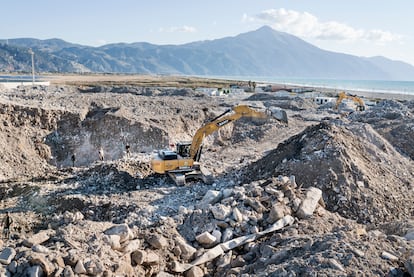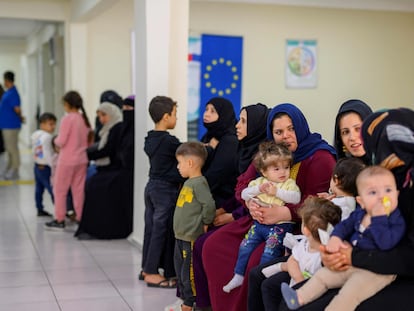Living among the ruins of the earthquake in Turkey a year later
One year has passed since the earthquake shook the south of the country and northern Syria in February 2023, killing more than 60,000 people. The removal of millions of tons of debris and fixing the damage caused to infrastructure and agriculture are threatening the health of survivors

When it rains in Antakya — the capital of the southernmost Turkish province of Hatay —the streets fill with mud. Huge puddles form on the roads, preventing you from seeing the deep holes in the asphalt, which was damaged by the earthquake in February 2023. Further damage has been caused by the movement of trucks and excavators, which, for the past 12 months, have been working on demolition projects and the clearing of debris in the city.
When it doesn’t rain, things are worse. Particles of what were once houses, businesses and monuments float in the air, covering everything with a layer of dust. The plants and trees that adorned the city take on a grayish tone. There are days when, from the mountains that surround the city, it’s possible to perceive an artificial cloud floating over everything.
The province of Hatay was the most-affected by the earthquake. One year ago, the disaster left more than 60,000 people dead and more than three million homeless in southern Turkey and northern Syria.
“Now, with the rains, we’re better off. Otherwise the air carries a lot of dust,” Baris explains. He’s a teenager who lives in a container house in a camp created by the Turkish government in Samandağ, a town south of Antakya, at the mouth of the Orontes River. There — right where the waters of the river open to the Mediterranean Sea — is an immense waste dump, where the remains of the buildings that collapsed during the earthquake or were demolished after it have been deposited. There are hills more than 30 feet high, made up of cement rubble, metal rods, pieces of wood and even some articles of clothing. At its summit — caked by the passage of machinery — the remains of old homes are barely sand. Gusts of wind easily carry it away. In the lower part, two excavators and several workers are, once again, removing the rubble. The authorities have given them a concession to find metal, which they then sell as scrap.
Safety regulations indicate that, before demolishing a building, materials that may contain toxic substances must be removed: asbestos in old roofs and insulation material, lead in pipes, mercury in fluorescent lights and electronic devices, and so on. But the area affected by the earthquake is so vast (larger than all of Portugal), the destruction so great (680,000 homes and 170,000 commercial, industrial and agricultural premises damaged or destroyed) and the need to build new homes so urgent that the authorities have given priority to speed over security.
According to the United Nations Development Program (UNDP), the earthquake has generated 3.5 billion cubic feet of debris, 10 times more than the Haiti earthquake of 2010. And hardly any hoses or irrigation systems are used to manage it — which would reduce the rise of particles into the air — nor do the operators wear mandatory masks. This all poses “a risk to public health,” according to a report by the NGO Support to Life.

The Turkish government assures the public that 91% of the demolitions and debris removal projects have already been completed, but “the exposure [to hazardous materials] hasn’t ended,” complains Sevdar Yilmaz, president of the Hatay Medical College: “The waste is being dumped near water sources, crops and inhabited areas. As soon as a little wind blows, dust will rise again.”
During the fall, the Turkish Medical Association (TTB) together with the Right to Clean Air Platform (consisting of 16 professional organizations and NGOs) carried out tests in various points in the provinces affected by the earthquake. In more than a third of the samples collected in Antakya and Kahramanmaraş — and in a tenth of those collected in Elbistan and Adıyaman — asbestos was found, a material whose inhalation can cause various lung cancers. “In the medium-term, we’ll see an increase in respiratory diseases and cancers. The life expectancy of people in the region will be reduced,” Yilmaz warns.
Turkey’s garden
The earthquake and debris haven’t only damaged people’s health. The affected provinces are responsible for 20% of food production in Turkey, especially the plains of the Hatay province, whose alluvial soils — so unstable and dangerous for construction work — are incredibly fertile for agriculture. “More than a third of the population of these provinces live from agriculture,” says the Food and Agriculture Organization of the United Nations (FAO). “An initial estimate indicates that agriculture has suffered a harsh impact, valued at $1.3 billion in damage [to agricultural infrastructure] and $5.1 billion in losses [due to the loss of crops and the resulting increase in food prices].”
“This past year, production has been lower, because the earthquake has damaged the wells and aquifers,” Mehmet laments. He’s a seller of salça (tomato paste) in the Antakya market. “The olive trees have also produced less, because of the dust,” says Orhan, who sells olives. The production of tobacco and apricots — the main agricultural products of the provinces of Adıyaman and Malatya, respectively — has also been affected by the earthquake.
Further south, in Samandağ, citrus production has been overwhelming. And yet, most tangerines rot on trees or on the ground in orchards. “It’s ruined,” Hussein sighs. A citrus farmer, he’s offered so little money for his yield that it’s not worth picking it. The reason, explains Trifon Yumurta — a local priest — is that the buyers who typically export to Russia, Romania and other countries haven’t shown up this year. “Maybe they’re afraid to come to the earthquake zone,” he shrugs.
The image of trees full of unpicked fruit in Samandağ contrasts with the situation in the refugee camps a few dozen miles to the north. According to a TTB study, most children don’t have access to adequate nutrition in container cities: they consume less fruit and much less meat and fish than recommended. The consequence is that more than 10% of children under two years of age show signs of malnutrition, with weights and heights significantly lower than average. This is because — despite the aid of between $100 and $150 per month that each affected family receives from the state — more than half of the heads of households in the area lack regular income and three-quarters don’t have stable employment. It’s also difficult to access food in a city like Antakya, where many markets remain closed.
Skin problems — such as scabies — and stomach conditions are common in the camps, all resulting from overcrowding and the difficulty in maintaining hygiene without proper water supplies. The TTB claims to have found E. coli and other potentially harmful bacteria in Antakya’s tap water. The central and municipal governments have denied this, although they haven’t dared to clearly state whether the city’s water can be consumed or not. “Both the earthquake and the work of the excavators and heavy machines have damaged the canalization and sewage systems. This can cause drinking water to mix with sewage,” Yilmaz explains.
The doctors left in the area cannot cope. The healthcare system collapsed during the earthquake and — although three hospitals in Antakya have been rebuilt — the number of beds available is 1,300… half of what it was before the earthquake. It also hasn’t been possible to reestablish the primary care system: the 66 centers that were once available remain closed, while almost half of the medical workers are missing. Many died, were injured, or have emigrated.
“Vaccination levels among children have plummeted from 98% to less than half,” laments the head of the medical association. “And what we feared for a long time has begun to happen: in Kırıkhan (another town in the province of Hatay), we’ve detected an outbreak of hepatitis A, with at least 40 cases.”
Sign up for our weekly newsletter to get more English-language news coverage from EL PAÍS USA Edition
Tu suscripción se está usando en otro dispositivo
¿Quieres añadir otro usuario a tu suscripción?
Si continúas leyendo en este dispositivo, no se podrá leer en el otro.
FlechaTu suscripción se está usando en otro dispositivo y solo puedes acceder a EL PAÍS desde un dispositivo a la vez.
Si quieres compartir tu cuenta, cambia tu suscripción a la modalidad Premium, así podrás añadir otro usuario. Cada uno accederá con su propia cuenta de email, lo que os permitirá personalizar vuestra experiencia en EL PAÍS.
¿Tienes una suscripción de empresa? Accede aquí para contratar más cuentas.
En el caso de no saber quién está usando tu cuenta, te recomendamos cambiar tu contraseña aquí.
Si decides continuar compartiendo tu cuenta, este mensaje se mostrará en tu dispositivo y en el de la otra persona que está usando tu cuenta de forma indefinida, afectando a tu experiencia de lectura. Puedes consultar aquí los términos y condiciones de la suscripción digital.
More information
Últimas noticias
Most viewed
- Oona Chaplin: ‘I told James Cameron that I was living in a treehouse and starting a permaculture project with a friend’
- Sinaloa Cartel war is taking its toll on Los Chapitos
- Reinhard Genzel, Nobel laureate in physics: ‘One-minute videos will never give you the truth’
- Why the price of coffee has skyrocketed: from Brazilian plantations to specialty coffee houses
- Silver prices are going crazy: This is what’s fueling the rally











































